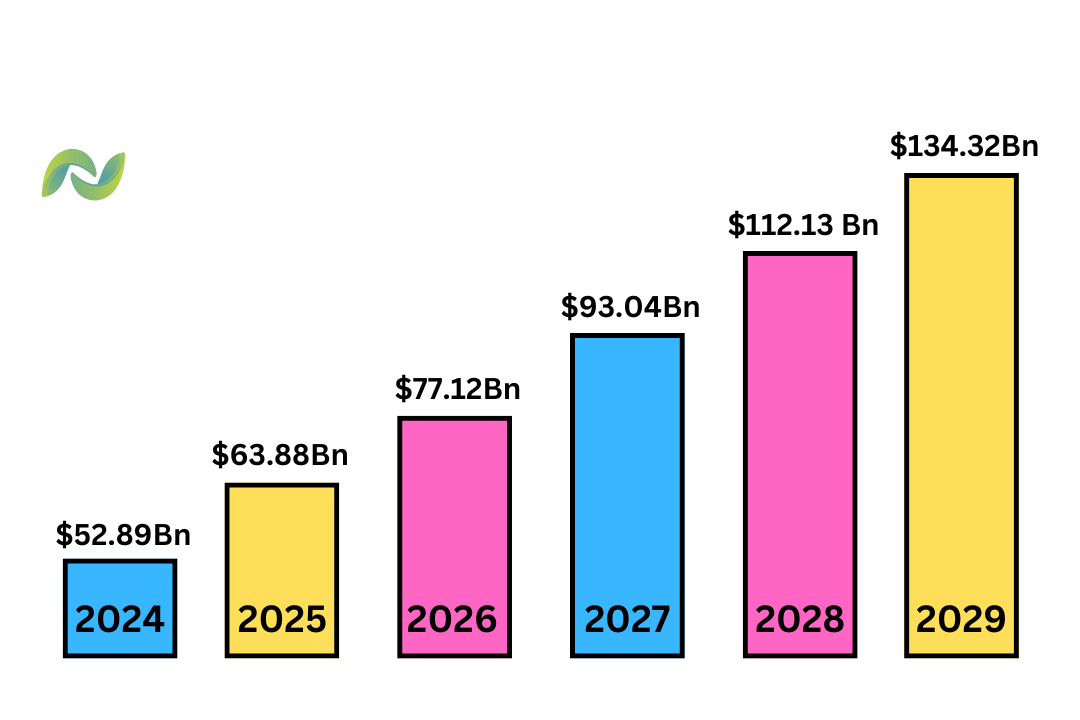How Much Does It Cost to Develop a Stock Trading App?
Nowadays, many people are getting into stock trading apps to buy and sell stocks on the go easily. Modern stock trading apps come with various features to aid investors, such as portfolio management, AI-based prediction tools, and much more. Due to the popularity of stock trading, many businesses are building and launching their applications to offer various stock trading facilities to investors. In this comprehensive guide, we will discuss the various factors deciding the stock trading app development cost in 2025. Let’s get started!
What is a Stock Trading App?
A stock trading app is a application that enables users to buy, sell, and manage various types of stocks and other types of financial tools directly through their smartphones. Many stock trading applications have built-in analysis tools to compare the price of any stock over time. All the stock-related stuff happens in the app in real time. These apps have assisted users by eliminating the need to visit stock trading websites again and again.
Global Statistics of Stock Trading Applications in 2025

As per the report by The Business Research Company, the market size of stock trading apps in 2024 was $52.89 billion and $63.88 billion in 2025. With a CAGR of 20.8%, the market size is expected to reach $134.32 billion in 2029.
Types of Stock Trading Apps and Their Cost Estimate
[1] All-in-One Trading App
This type of app is generally owned by large trading and brokerage firms that offer a wide range of financial and investment services. These apps target long-term investors or people who want advanced resources for guidance. There are many features of full-service trading apps, such as in-depth research tools, real-time market analysis, personalized investment recommendations, and access to a wide range of assets, such as stocks, ETFs, mutual funds, and bonds etc. It acts as a single platform for mutual funds, the commodity market, and crypto etc.
Cost Estimate: $50,000 to over $150,000.
[2] Robo-Advisory Apps
These mobile applications automatically manage the user’s portfolios by using AI and advanced machine learning algorithms, thus providing a seamless experience to users. These apps target passive investors and traders who prefer automated management over manual trading. Some of the features are setting financial goals, choosing risk levels, and creating and rebalancing portfolios accordingly.
Cost Estimate: $15,000 to $50,000.
[3] Forex Trading Apps
The purpose of forex trading apps is to provide a platform for users to buy and sell stocks in foreign markets. Forex trading applications allow users to buy, sell, and monitor currencies in real time. These apps have many features such as real-time market data, trading tools such as charts, technical indicators, etc, order execution, account management to manage funds, etc.
Cost Estimate: $30,000 to $80,000.
[4] Social Trading Apps
Social trading apps blend trading with social interactions, so that people can learn and interact with other traders in a community-focused environment. These apps target investors looking for mentorship, networking, or collaborative trading opportunities and have features such as copy-trading, forums, real-time trade sharing, and sentiment analysis etc.
Cost Estimate: $20,000 to $60,000
[5] Cryptocurrency Trading Apps
Cryptocurrency trading apps are decentralized applications that deal with crypto trading activities such as buying, selling, and managing cryptocurrencies and transactions. These apps are developed for crypto enthusiasts and traders and offer features such as secure wallets, multi-layer encryption, real-time price tracking, and crypto-to-crypto exchange features and functionalities.
Cost Estimate: $40,000 to $150,000 or more.
[6] Paper Trading Apps
Paper trading applications are web apps or mobile apps in which users can practice stock trading in a simulated environment. These apps provide simulated real-time stock market conditions using virtual money. These apps offer many features, such as performance tracking, to help users track their learning. Examples include Virtual Trading App 2.0, etc.
Cost Estimate: $20,000 to $70,000.
[7] Technical Analysis Software
It is a web app or a downloadable desktop software that is used by professional and experienced traders to accurately analyze the stock and financial markets by analyzing the market trends, patterns, and movements. These apps have many features such as indicator strategies, pattern recognition, charting tools, backtesting, etc. Some examples include Metastock, NinjaTrader, TradingView, StockCharts, etc.
Cost Estimate: $20,000 to over $200,000.
[8] Stock Trading Apps
A stock trading app is a widely used mobile application that is used to buy, sell, manage stocks, ETFs, mutual funds, and other financial assets. These apps contain a wide range of tools such as charts, real-time market data, trade execution, portfolio management, push notifications, etc.
Cost Estimate: $15,000 to $50,000.
Estimate of Stock Trading App Development Cost With Features
[1] Real-Time Market Data
Description: Users can easily see the real-time market data such as stock prices, indices, and trends etc on their app.
Integration Cost Estimate: $2,000 to $3,500.
[2] Advanced Charting Tools
Description: This feature provides interactive charts with technical indicators and KPIs for stock analysis.
Integration Cost Estimate: $2,500 to $4,000.
[3] User Portfolio Management
Description: This feature allows users to track their investments, gains, and losses.
Integration Cost Estimate: $5,000 to $9,000.
[4] Watchlist
Description: Users can keep an eye on specific stocks of interest.
Integration Cost Estimate: $4,000 to $8,000.
[5] Push Notifications
Description: Push notifications send alerts for price movements, market updates, and trading opportunities.
Integration Cost Estimate: $5,000 to $8,000.
[6] Secure Login and Transactions
Description: This is one of the most essential features that ensures user accounts and transactions are protected with robust security measures.
Integration Cost Estimate: $10,000 to $20,000.
[7] Trade Execution
Description: As the name suggests, this feature enables the smooth buying and selling of stocks with minimal latency.
Integration Cost Estimate: $10,000 to $20,000.
[8] Educational Resources
Description: This essential feature provides tutorials, articles, and insights for beginner and advanced traders.
Integration Cost Estimate: $5,000 to $10,000.
[9] Payment Gateway Integration
Description: A secure payment gateway integration enables secure deposits and withdrawals.
Integration Cost Estimate: $7,000 to $12,000.
[10] AI Chatbot and Customer Support
Description: An AI chatbot or a live representative offers real-time assistance to user queries.
Interaction Cost Estimate: $5,000 to $8,000 or more.
Factors Affecting Stock Trading App Development Cost
[1] Complexity of Features
Complexity and features play a crucial role in deciding the cost of stock trading app development. The more features, the higher the cost. Basic features like account setup, trading options, and stock charts are relatively less expensive. But advanced features real-time data analytics, AI-driven investment recommendations, or customizable trading dashboards, etc, cost much higher due to the longer development time required.
[2] Selection of Platform
Platform selection is also important when determining the cost to develop a stock trading application. Developing mobile apps for individual platforms such as Android and iOS increases costs since the app needs to be developed and optimized separately for each platform. You can have cross-platform app development, as it would reduce the overall costs to build a single app for both platforms, but sometimes, performance and scalability might be impacted.
[3] UI/UX Design Quality
UI/UX design is what engages the user in a stock trading app. Developing a sleek and intuitive design that simplifies complex trading processes generally costs more. A high-quality design ensures user satisfaction and loyalty, but increases the overall development costs due to the expert designers involved in creating it.
[4] Security Features
Security is a very important aspect of stock trading app development as these apps deal with sensitive financial data, making robust security a non-negotiable factor. Features such as end-to-end encryption, two-factor authentication, secure payment gateways, and compliance with financial regulations like GDPR or PCI DSS add to the overall costs.
[5] Third-Party Integrations
Third-party integrations increase the overall features and functionality of the stock trading application. APIs such as live market data providers, news feeds, payment processors, payment gateways, and CRM systems, etc, require subscription and licensing fees that add up to the cost.
[6] Developer Expertise and Team Size
Developer expertise and team size/ also affect the cost of stock trading app development. A freelancer charges less as compared to a large or small-sized team. An experienced developer would charge more but will deliver a quality and efficient product.
[7] Maintenance and Updates
Maintenance and regular updates ensure the app works without any issues. Adding new features or modifying the app requires time and resources, and the development team or a stock trading app development company would charge monthly for that.
[8] Location of the Development Team
The location of the development team also matters when it comes to the stock trading application development costs. Mobile app developers from regions like North America or Europe generally charge more compared to those from Asia or Eastern Europe.
Follow a Step-by-Step Stock Trading App Development Approach

[1] Market Research and Planning
Start by conducting a thorough market research and analyzing the stock trading industry to identify trends, gaps, and opportunities. Identify the target audience, and define the mobile application’s purpose and scope based on user needs, such as trading stocks, mutual funds, ETFs, or cryptocurrencies. Also, conduct detailed research on your competitors and determine what is unique that you can offer to the audience. Afterwards, set clear goals, objectives, timelines, etc. Cost: $3,000 to $10,000.
[2] UI/UX Design
An engaging user interface offers a great user experience to the stock trading app users. Create wireframes that outline the app’s structure and layout. Then, convert the wireframes into prototypes to simulate the user experience. Focus on simplifying navigation and displaying information in an easy-to-understand way, like using graphs, charts, and color-coded indicators. Ensure the design offers a seamless experience across all levels of expertise. Cost: $5,000 to $20,000.
[3] Choosing the Tech Stack
Selecting the right tech stack is an important part of the whole process. There are many different languages and frameworks for both native and cross-platform applications to choose from, such as Java, Python, Dart, Flutter, React, etc. Decide whether your mobile app needs cloud hosting services for scalability, and ensure your tech stack supports future updates and integrations. Cost: $3,000 to $10,000.
[4] Backend Development
The backend is the most important part of the stock trading app. The backend supports essential functions like user authentication, secure transactions, stock trading algorithms, security features, and real-time data integration etc. Set up robust databases to store user data and trading records efficiently. And, integrate APIs to connect with external services, such as live stock data providers, payment gateways, and news feeds. Cost: $10,000 to $50,000.
[5] Frontend Development
The frontend focuses on developing the user interface and implementing the designs using HTML, CSS, and JavaScript for web-based platforms or native code for mobile applications. Ensure that the frontend is responsive, visually aligned with the design prototypes, and optimized for performance and smoothness. Cost: $5,000 to $30,000.
[6] Testing & Quality Assurance
The testing phase is conducted after the main app is fully developed as per the SRS. Conduct rigorous testing in a simulated environment to ensure that the mobile app works fine without any bugs or errors. Incorporate unit testing, integration testing, system testing, functional testing, non-functional testing, user acceptance testing, etc. Cost: $3,000 to $15,000.
[7] Deployment & Maintenance
Once the app completes the testing phase, it is ready to be deployed on the respective app stores of the platforms (Android and iOS). Ensure the app meets the app store’s guidelines and then publish the app. Afterwards, launch extensive marketing campaigns to ensure the app reaches a wider audience. Maintenance also includes monitoring app performance, responding to user queries, improving security measures over time, and providing updates to ensure that new features are regularly added and the app keeps up with the changing market trends. Cost: $10,000 to $25,000 (initial), $2,000 to $5,000/month (ongoing).
Use the Latest Tech Stack for Stock Trading App Development
[1] MEAN Stack: MongoDB, Express.js, Angular.js, Node.js.
[2] LAMP Stack: Linux (OS), Apache, MySQL, PHP.
[3] MERN Stack: MongoDB, Express.js, React.js, Node.js.
[3] Native Development: Java, Kotlin.
[4] Cross-Platform Development: Flutter, Dart (Programming Language).
[5] Cloud: AWS, GCP, Azure.
[6] APIs: REST, SOAP, GraphQL.
How to Monetize Stock Trading Apps?
[1] Freemium Model
The freemium model is one of the most widely used monetization models in mobile apps. You can provide free but limited access to features and functionalities such as tracking stock prices, viewing charts, or executing limited trades, and charge money in exchange for accessing advanced features.
[2] Subscription Plans
You can provide users with monthly or yearly subscription plans that offer premium and specialized tools and features such as real-time data feeds, market sentiment analysis, algorithmic trading bots, or community features like exclusive webinars and forums organized by experienced investors and traders.
[3] In-App Purchases
You can offer many different items apart from subscription plans as a one-time purchase. The items can be accessed to industry trend reports, individual stock ratings, or additional cloud storage for saving detailed analysis, etc.
[4] Advertising
You can enable sponsored ads in your stock trading app for extra revenue generation. Ads should be placed strategically in such a way that they do not interfere with the user interface.
[5] Affiliate Marketing
This method includes collaborations with outside brands. When a user enrolls in a suggested service, like a credit card, banking service, or investment advisory, the app receives a commission in return.
Some Suggestions to Optimize Stock Trading App Development Costs
[1] Define Clear Objectives and Features
Defining clear goals, features, and functionalities of the stock trading app, such as user-friendly interfaces, secure payment gateways, real-time market updates, and trading tools. Utilize Minimum Viable Product or MVP as it will enable the development of the app with core features and later upgrade it as per the user feedback.
[2] Choose the Right Development Team
Select the right development team as per your project type and complexity. A small team would cost less, but the delivery time would be longer; a larger team would deliver faster but cost more. Hire a stock trading app development company to maximize the development output against your overall budget.
[3] Use Cross-Platform Development Tools
Cross-platform tools such as Flutter offer single-code development solutions for multiple platforms, such as Android and iOS, as well as web applications. This reduces the overall time and resources to build a single app for multiple platforms.
[4] Leverage APIs and Pre-Built Solutions
Use third-party APIs and platforms instead of developing them from scratch, as the initial cost is generally less and often comes with a subscription plan or a licensing fee. This will allow the developers to simply integrate the API into the app instead of spending time and resources to build it.
[5] Implement a Scalable Cloud Infrastructure
An app needs to be scalable so that future updates can easily be installed and increase the overall features and functionalities of the mobile app. Leverage the cloud infrastructure as it saves a lot of time and resources in developing infrastructure for the app. Also, cloud platforms come with subscription fees, which are cost-effective in the long term.
[6] Focus on Security Compliance Early
Ensure compliance with financial and data security standards (e.g., SSL encryption, GDPR, PCI DSS) from the beginning to avoid costly fines or rebuilds down the line, which could be very expensive in the long run.
[7] Adopt Agile Methodology
Use Agile methodology as it allows iterative work cycles, enabling better resource allocation and reducing waste. It also helps identify and fix issues early on, preventing expensive upgrades later on.
[8] Gather User Feedback Early
Launch a beta version of the app with the core functionalities and give users access. When the app is used in a real-time situation, the users provide feedback for any improvements and suggestions. Enhance the app as per the feedback to avoid costly post-launch updates.
How Next Olive Can Provide You the Best Value for Your Investment?
Next Olive is the leading stock trading app development company with over 13 years of experience providing stock trading app development services to over 20 different countries, such as the USA, UK, Saudi Arabia, UAE, Malaysia, Australia, etc. We have over 150 experienced and dedicated stock trading app developers who can turn any app idea into reality. We have served many industries by incorporating 4 essential values: delivering the project on time, enabling end-to-end and transparent communication with the client, having a client-centric approach, and offering cost-effective solutions. We have built trust among many firms, and you can rely on us for any business-related issue, and we will solve it with technology.
Conclusion
In conclusion, we discussed the various factors influencing the cost of stock trading app development in 2025. Developing a mobile application requires significant investment and time. You can hire a stock trading app development firm or hire a freelancer. The team size and location also matter in determining the overall development costs. However, you can optimize and reduce the costs by leveraging MVP and cloud platforms for development and scalability.
Frequently asked questions (FAQs)
How much time does it take to develop a stock trading application?
The time required to develop a stock trading mobile app depends on various factors, such as type, size, complexity, platform, etc. Generally, it is between 2 to 4 months for a basic app, 4 to 8 months for a medium-complexity app, and 8 to over 12 months for a highly complex app.
Do you offer cryptocurrency exchange app development services?
Yes, we provide best-in-class cryptocurrency exchange development services. We also offer white label cryptocurrency exchange services.
Have you integrated AI and ML features into your stock trading apps?
Artificial Intelligence and Machine learning are the latest technologies, and we integrate them into our stock trading mobile applications for data-driven insights and decision-making tasks.




